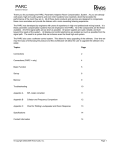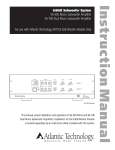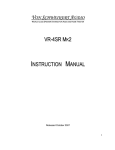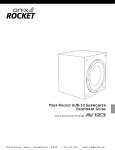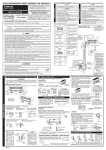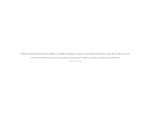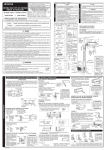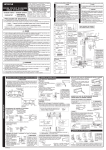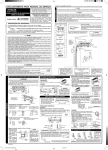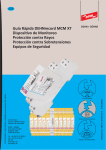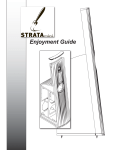Download AV123 ULW-10 Owner`s manual
Transcript
Your Rocket UFW-10 Subwoofer Enjoyment Guide Yours exclusively through 1001 Delaware Ave. • Suite C • Longmont, CO 80501 • Toll Free 1-877-543-7500 • e-mail: [email protected] A Suggestion Your Rocket UFW-10 subwoofer is carefully hand-packaged utilizing molded foam inserts to protect its fine furniture-grade finish. Please use care when unpacking your new subwoofer. When removing it from the box, hold the wood sides of the cabinet, while taking care not to exert pressure on the front cloth grille. We strongly recommend that you save the foam inserts and shipping cartons to protect your speakers, should you ever need to move or ship them to a new location. Thank you. And Congratulations! Our thanks for buying Rocket Series speakers from AV123. We sincerely appreciate your confidence in us and our products. Although we know these speakers represent extraordinary value, we also know that the real test is how you feel about your speakers several months from now. That’s why AV123 will continue to work hard to earn your respect with technical advice and customer service that is second to none in our industry. You can visit the AV123 website (www.av123.com) at any time for up-to-date product information, answers to FAQ’s, or to seek advice from the AV123 community at our new online forum (www.av123forum.com). Should you require that personal touch, please don’t hesitate to contact our support department, toll-free, at (877) 543-7500. You’ll find our knowledgeable Technical Services Department eager and willing to help. We ask you read this owner’s manual first. It contains many tips on getting your new subwoofer set up, connected, configured, and performing its absolute best in your unique environment. We hope you find it clear, concise, and useful. Again, thank you for your support. Your Rocket UFW-10 Subwoofer Enjoyment Guide Table of Contents Introduction Section 1—Product Overview • • 1.1 Control Panel Features 1.2 Brass Feet, Discs, and Rubber Feet a. Spike Feet b. Brass Discs c. Rubber Feet Section 2—Subwoofer Placement and Location • • 2.1 Subwoofer Placement 2.2 Subwoofer Location Section 3—Connecting Your UFW-10 Subwoofer Section 4—Setting Up Your Surround Processor or Receiver • • • • 4.1 4.2 4.3 4.4 Small or Large? Simple Calibration Crossover Settings UFW-10 Phase Adjustment Section 5—Advanced Calibration and Correction • • • 5.1 Performing a Room Frequency Sweep 5.2 Interpreting the Results 5.3 Advanced Parametric EQ Adjustments Section 6—Proper Care and Feeding • • • • 6.1 6.2 6.3 6.4 Warranty Policy and Terms Stay in Touch! UFW-10 Specifications Miscellaneous Thank you for your support Introduction to AV123 and your new Rocket UFW-10 Subwoofer Section 1—Product Overview 1.1 Control Panel Features (see figure 1.1) At AV123, our absolute highest priority begins and ends with you, the customer. You can rest assured that if you’re not 100% satisfied with your purchase within 30 days from your original receipt date, you may return your product(s) for a prompt refund in full (excluding shipping charges) no questions asked. In addition to the expert advice available on our website, or through our trained advisors, there is simply not a safer way to buy. At AV123, misleading and high-pressure sales tactics are a thing of the past. Not only do we offer you the tools and resources necessary to fully evaluate your purchase before the order is placed, we’ll back each and every sale after the fact with our in-home trial period. We’ve done our best to provide you with products and services meeting or exceeding your expectations. However as good as our products are, they do not match our dedication to each and every sale. Should you need any further assistance in the future with your A/V system, you can bet that AV123 will be there supporting and assisting you as you make your way to your next level of audio/visual enjoyment. The Onix Rocket UFW-10 (Ultra Fast Woofer) is a very potent and agile subwoofer. Special care and attention was given to the UFW to ensure clean, accurate, and extremely detailed low-end performance in both music and home theater systems. Features include a 500-watt amplifier, single band parametric equalizer, adjustable crossover, and infinite phase adjustment for easy in-room placement. This flexibility will result in a seamless blend with all Onix loudspeakers, as well as those from other manufacturers. A. Power switch B. Power On Indicator – Glows brightly when the unit is on. Glows dimly when unit is in standby. The unit will automatically turn on in the presence of an audio signal. Approximately 15 minutes of signal absence will cause the subwoofer to go into standby mode. To fully turn off the unit, please unplug it from the wall. C. Line Fuse – The UFW-10 is equipped with a 4-amp fast blow fuse. Always replace with the same rating. D. Power Cord – A standard IEC socket allows removal of the power cord. E. LFE/MONO XLR (balanced) connection. If your preamplifier has XLR output available, use this connection. F. Audio Inputs – Standard RCA (unbalanced) type cables will work here. If your preamplifier or receiver has only one sub out, use the R (L+R Summed) connection. G. Crossover In/Out switch – When set to IN, the crossover is activated. When set to OUT, the crossover is disabled. H. Crossover Adjustment – This controls the high-frequency cut off. Generally this is set to 80Hz if used. We will cover this in detail later in the manual. I. Phase – This controls the phase of your subwoofer relative to the rest of your speakers. Rotate this dial in small amounts while you listen at your listening position for the most bass. J. Gain – This control allows you to match the output of your main/satellite speakers to the sub. Set this to the lowest level when powering your system for the first time. When calibrating your system, do not exceed 75% gain. You’ll want some room for adjustment...try to avoid setting the gain in either your receiver (through the channel “trim” menus) or your subwoofer near maximum levels. Doing so will also minimize the potential for a distorted input signal. K. EQ – Single band parametric equalizer. Includes controls for Frequency, Bandwidth and Level. Use these controls to modify the frequency response at any point. The frequency range is 20Hz to 80Hz…bandwidth from 0.1 to 1.0 oc- Figure 1.1 taves…and a level adjustment from –15dB to + 6dB. 1.2 Brass Feet, Discs, and Rubber Feet Spike Feet Included with your Rocket UFW-10 subwoofer are the same high quality threaded spike feet used on all Rocket Loudspeakers. For carpeted floors, simply screw the spikes into the threaded inserts located on the bottom of your UFW-10 Subwoofer. On uneven surfaces, use these feet to help compensate. Brass Discs To protect your hard flooring surface, we have also included metal discs to provide a contact point between your speaker spikes and the floor. To use, simply place the disc under the spike such that the small indentation is aligned with the point of each foot. Rubber Feet As an alternative to both methods above we’ve also included soft selfadhesive rubber bumpers with your UFW-10 Subwoofer. These provide a safe alternative to the metal spikes, and will also absorb any vibrations between the subwoofer and underlying surface. The choice is yours for preference and practicality, but you'll find the results to be very good either way. Section 2—Subwoofer Placement and Location 2.1 Subwoofer Placement board 1 band parametric equalizer. As “boomy” bass is often the result of the largest untamed peak, we're confident that you will find this feature an indispensable tool for shaping your subwoofer into the way you'd like to hear it. Flat, clean, and powerful. More on this in section 5. 2.2 Subwoofer Location The low frequencies played by your UFW-10 subwoofer tend to be non-directional due the extraordinarily long wavelengths involved. As a result, regardless of where your subwoofer is placed, it should not be easily localized, but should instead produce a balanced and enveloping response. Factors that can affect performance in this regard are rattles from shelves, walls, or other nearby objects, as well as distorted output. If you are having issues with subwoofer localization, try to isolate any rattling or buzzing objects, or place the sub in another corner of your room. If the sub's output is distorted, check to see that you are not at the maximum sub level setting on your receiver or pre/pro. An overdriven output can induce audible distortion. To resolve, you may need to turn down the subwoofer level on your processor and turn the gain level up on the subwoofer itself to compensate. Section 3—Connecting Your UFW-10 Subwoofer Figure 2.1 Unlike regular loudspeakers, subwoofers will often work best when placed in a corner, even if located a few feet to the side and/or behind the closest main speaker. Typically the front right and left corners sound the most natural, though rear corner placement is also an acceptable option. The driver can be facing you or be pointed along either wall. The low frequency sound waves emitted by the UFW-10 are quite long and will therefore interact greatly with the walls of your room. As a result, even small placement adjustments can have a significant impact on the sound you hear. A room corner will provide maximum output at a given power level, and the maximum number of room modes will be excited, translating to a flatter response in most rooms. Often one rather large peak in the subwoofer’s operational frequency range will stand out with corner placement,. For this we've also provided the UFW-10 with the ability to alter its response for your new environment with an on- NOTE: Please be sure your subwoofer is not plugged in and the rest of your system is turned off. LFE Output Or Mono RCA/XLR Interconnect L+R Summed Input Figure 3.1 When making your connections, be sure to use a high quality and reliable interconnect cable. It should be shielded and long enough to do the job, but not excessively long. Your subwoofer cable is likely to be the longest interconnect in your system. The simplest and recommended connection between a home theater receiver or processor and your UFW-10 Subwoofer is directly from the sub/ LFE output to the “R” (L+R summed) input on the UFW-10. If your processor has a "balanced" subwoofer output, it's use is recommended. See figure 3.1. If used with a 2-channel integrated amplifier, or any source without a dedicated sub/LFE output, you will need to use both the L and R inputs on the UFW-10’s back panel from a low-level output on your preamplifier or receiver. Often “Tape” or “Monitor” outputs will provide an appropriate low-level stereo signal if the dedicated output does not exist. See figure 3.2 below… Stereo R and L Output Stereo pair RCA Interconnects sub-80Hz information better than "most" loudspeakers in "most" rooms. This is mainly due to the tendency for competing sources of information below 80Hz to result in destructive bass wave cancellation, thus eliminating the very frequencies your subwoofer was designed to play. In addition, when crossed over with your UFW10, the other loudspeakers in your system will play with greater ease and less distortion, free from the demands of deep and complex sub80Hz waveform reproduction. Your speaker system amplifier will be less taxed as well, since much of the stress of producing deep bass will be eliminated. Consequentially your loudspeakers should sound cleaner and more controlled. An easy and "user friendly" way to test different methods and frequencies for crossing over your subwoofer is to use low frequency sweeps recorded on special program material. One of our favorite is the "AVIA Guide To Home Theater" DVD. Specifically, the tones that descend in frequency from the individual satellite speakers to the subwoofer are quite useful and effective. Using your SPL meter (explained in the following sections), watch for the smallest amount of overall needle fluctuation while you direct and descend the tones from speaker to subwoofer as you go around your system. In other words, the point at which the signal transitions between your satellites and subwoofer should be completely seamless and without definition. 4.2 Simple Calibration Figure 3.2 Section 4—Setting Up Your Surround Processor or Receiver 4.1 Small or Large? Many of today’s surround processors and home theater receivers will allow you to set all 5 speakers in your room to either small or large, thus changing the way your UFW-10 interacts with your system. Like almost all things audio, which setting to use is somewhat subjective, though it’s also a function of your room. By a good majority, most rooms will obtain their best sound with all speakers set to "small" and crossed over to the UFW10 at 80Hz. Of course this is assuming the use of a high performance subwoofer such as the UFW-10. A strong sub ideally placed will handle To begin configuring your subwoofer for optimum performance (a) in your room and (b) in combination with your other loudspeakers, you’ll first need a Sound Pressure Level (SPL) meter. Radio Shack sells an analog SPL meter (shown to the left) that works very well for this purpose. Set the meter to "Slow" with a “C” weighting. The dial should be set at either 70 or 80 depending on your pre/pro or receiver’s test tone level. Consult your owner’s manual to determine what reference point your unit uses. Most use 75dB, so the "70" setting on the meter would be appropriate for them. Let's start by setting the level of your sub to match the rest of your speakers. • From the receiver or pre/pro's speaker calibration menu, set the subwoofer level to 0dB. Start with the gain on the subwoofer around 1/4 to 1/2 of the way up from the -15 mark. • In the speaker configuration menu, be sure all your speakers are set to “small” with subwoofer to "yes". For this exercise, the crossover should be set to 80Hz. • Set the volume control on your pre/pro or receiver to the "00 dB" level. See the note below if your unit uses a positive number scale for volume instead of a minus-to-plus scale. • Ensure that all main, center, and rear channels are calibrated to the reference point using your test tones, then direct the tone to the subwoofer. Adjust it's level using the gain control on the subwoofer itself until it reaches the sound pressure level used for the other speakers. An assistant is very helpful in this process. Some like to run their sub a bit louder (“hot”) for movies by increasing the sub level (in the receiver’s control panel) by 5dB or so above the main channel level. This can be very effective at lower listening levels, but be sure to use care when watching that big action movie for the first time...especially at or near reference levels! Once the subwoofer is calibrated, small adjustments can be made easily using the subwoofer level control in your processor. If you find the need to go much above +2 or +3 consistently, we recommend adjusting the gain control on the sub’s amplifier upward rather than using the receiver’s volume control—this will eliminate the possibility of the subwoofer receiving a distorted input signal. Conversely, using too low of a value for the subwoofer level on the processor may result in difficulty keeping the subwoofer's auto-on feature "awake" during quiet passages. Note: If your unit does not use a minus/plus volume scale, activate the test tones and increase the volume of your pre/pro or receiver until it reaches 75dB or 85dB on your SPL meter. Remember this number as this will be “reference level*.” Remember to check with your unit’s manual to determine if they use a 75dB or 85dB test tone. *What is reference level? Reference level allows for peaks of 105dB from the speakers and 115dB for the LFE channel. When calibrated as above, the correct relative volume of each speaker will be as the director/sound engineer of the film intended. 4.3 Crossover Settings Your UFW-10 Subwoofer features a defeatable, continuously variable crossover that allows you to set a low-pass filter at any point between 40Hz and 150Hz. In addition, many popular receivers and surround processors also feature built-in electronic crossovers (please consult your receiver’s instruction manual). If present, we recommend using your receiver’s crossover and setting the UFW’s crossover switch to “out” thus disabling this feature. After setup is completed, during which an 80Hz crossover is recommended, you can adjust your crossover accordingly either in the subwoofer itself or as recommended in your receiver’s setup menu. Typically, the smaller your speaker OR the louder the system will be played, the higher the crossover point. Conversely, larger speakers OR lower volumes allow for lower crossover settings. The THX standard, and the recommended crossover with your UFW-10 is 80Hz for home theater. 4.4 UFW-10 Phase Adjustment The phase dial (see “I” on figure 1.1) controls the relative phase of the subwoofer to best reinforce the other loudspeakers in your system. Adjustments to this control will change your UFW-10’s interaction with the rest of your speaker system, providing the least cancellation, and thus the best response in any room. With SPL meter in hand (or, better yet, on a tripod), play an 80Hz tone (for this exercise the crossover point must be set to 80Hz) and slowly rotate the phase control from "0" towards “180.” Watching your SPL meter, find the point that results in the biggest peaks in sound pressure levels (i.e. reads highest on the meter). This setting indicates the least amount of bass wave cancellation, and should be held constant until the subwoofer or other speakers in your room are moved, or placement is altered in any way. With typical front corner placement in most rooms, you may very well find the "0" setting to be optimum. Section 5—Advanced Calibration and Correction One of the most impressive features of your UFW-10 Subwoofer is the built-in parametric EQ shown as “K” in figure 1.1 and detailed below in figure 5.1. Depending on the nature of your room or listening environment, your subwoofer may be reinforcing certain frequencies in the UFW-10’s operating range such that they are significantly louder (at your listening position) than the desired response. Using the three dials shown in figure 5.1 below, the UFW-10’s para- channels to reference level, set your sub’s volume to 70dB. d. Play a 20Hz track from a test tone CD, such as one available through www.rivesaudio.com, and record BOTH the frequency (your x-axis), which corresponds to the track on the test disc, and the SP level (your y-axis) as shown on the meter. e. Next, play the tracks from 25Hz to 120Hz and record the SP Level for each frequency played. Important Note: The RadioShack sound meter uses C-weighting. As a result, a correction key is needed to ensure proper response before your final measurements are plotted. We suggest gathering your data using the readings on the meter and then correcting your results with the compensation coefficients shown in figure 6.1 (at the end of this manual). The Rives disc mentioned above includes compensated test tones. 5.2 Interpreting the Results Once you’ve completed this exercise, you will have a data list much like that shown in figure 5.2 below (though much more detailed and complete). Figure 5.1 metric equalizer will allow you to flatten up to 1 peak in your room, thus giving you the flattest (most natural) overall response. In order to find out exactly how your room is affecting your UFW-10 Subwoofer, you need to perform a “frequency sweep” of your room. This will give you a graphical representation of how the UFW-10 is performing in your unique listening environment. 5.1 Performing a Room Frequency Sweep Though there are a number of ways to perform an accurate frequency sweep, we’ve detailed the steps involved in the most basic method below. a. Sit in your favorite seat and hold your Radio Shack SPL meter at a 45-degree angle half way between horizontal and vertical. b. The meter should be placed at ear level when seated in the primary listening position, and is best if supported by a stationary object such as an end table or tripod. c. Assuming you have already calibrated all Frequency (Hz) Gain (dB) 20 64 25 67 32 70 40 71 55 74 63 71 80 72 100 70 Figure 5.2 Now that you have a complete data set derived from YOUR room, you need to plot this response visually, either in MS Excel or simply on graph paper (a computer application is recommended to smooth the curve) to obtain a graphical representation of your room’s effect on the UFW-10. An example, derived from figure 5.2 above, is shown on the following page in figure 5.3. the filter to be applied. In our example above, we want to tame the peak that is centered at just about 45Hz, and thus set our frequency filter to the corresponding 45Hz level. 79 73 67 30 50 80 Frequency (Hz) Figure 5.3 Note the relative flatness of the overall response as well as the magnitude of your largest peak. Some nulls are likely to be present, however filling in a null or dip with any EQ is not likely to be effective, and the power required can make such an attempt undesirable. If desired or necessary, you may wish to try moving the sub to a new location for a flatter response. Sometimes only a few inches can make a significant difference. It's recommended that these tests be performed using the same speaker configuration and placement you'll be using while enjoying your system, such that the interaction between the speakers and the subwoofer can be observed. By and large we recommend sticking with front corner placement if possible for the benefit of the "corner loading" increase in output, thus using the EQ only to flatten the response. B) Bandwidth—The bandwidth control on your UFW-10 allows you to set the WIDTH of the filter you want applied. This control is based on a percentage of a full octave above, or a doubling of frequency. Thus, when set to 1.0, the width of the area you’ll be cutting or boosting will be a full (one) octave, corresponding to an overall width (start to finish) of double the frequency (half above AND below your center point). In this example, we estimate the “beginning” of the peak in figure 5.3 to be at about 25Hz and the “end” of the peak at about 80Hz...a range of Center 25Hz (45Hz) Desired Curve Width 30 50 80Hz 80 Figure 5.4 around 55Hz. 5.3 Advanced Parametric EQ Adjustments And the fun begins... For this adjustment, you will need a test disc with frequencies from at least 20Hz to 120Hz. Stereophile Magazine and the previously mentioned www.rivesaudio.com have test discs available for sale, or you can create your own disc with a CD writer using files found on the internet. A web search should yield suitable tones. Once your data is plotted as shown in figures 5.2 and 5.3 , use the Frequency (A), Bandwidth (B), and Level (C) controls (as shown in figure 5.1) to adjust your subwoofer’s response as follows: A) Frequency—This control allows you to set the exact point at which you want the CENTER of However, the 45Hz point is not centered in this range. Because the EQ needs a range equidistant to each side of our center frequency, set in step 1, we have to extend our area slightly (or move our center point...more on this later) to fully compensate the range we require. Thus, in this example, because we want our high point at 80Hz, or 35Hz above our 45Hz center frequency, we also have to adjust 35Hz below our center frequency, therefore expanding the width of our “beginning” and “end” points to 10Hz and 80Hz respectively (as shown in figure 5.5). need our width points, we must calculate the percentage of a full octave this translates to. This can be done with the following equation: [(Bandwidth)x(Center Hz)] + (Center Hz) Which breaks down to: Center Actual Curve Width 10Hz Bandwidth(B) = High Cutoff(H) - Center Hz(C) Center Hz (C) (45Hz) 80Hz Thus, in this example, we substitute our points as follows 20 30 50 Figure 5.5 80 However, in this example, there is one problem...our low point is far below the actual width of our desired curve, thus even the flat portion of the UFW’s desired response will be attenuated. To avoid this, we need to move our center point up just a bit, such that it is closer to equidistant between our “beginning” and “end” points. In other words, if we move our center point up from 45Hz to 55Hz, our “end” point of 80Hz is now only 25Hz above our center (instead of 35Hz), and our “beginning” point is now 30Hz below our center (instead of 20Hz). Because we must be equidistant from this center frequency, our range thus becomes 25Hz to 85Hz—much closer to our desired value. In addition, because the system will likely be crossed over at 80Hz, the additional attenuation above the actual curve will not affect the UFW’s response. (B) = (H) 85Hz - (C) 55Hz (C) 55Hz And, finally, we have B = 0.55. In other words, the bandwidth dial should be adjusted to 0.55 in order to set a curve width between 25Hz and 85Hz on a 55Hz center point. C) Level—Now that we’ve defined our peak’s width, we move on to the goal of this exercise...to flatten it out. For this, we need to decide how much boost or cut will be necessary. In our sample data, our center frequency (55Hz) 74 72 70 (C) 68 20 Figure 5.7 New Center 25Hz 20 (55Hz) Actual Curve Width 30 50 85Hz 80 Figure 5.6 Now that we know how far above and below we 30 50 80 Hz corresponds to a gain of right about 74 dB. However, as you can see in the above figure, the rest of our curve is flat at about the 69 dB level. Thus, in this example, a 5dB cut applied to our curve will sufficiently “tame” this peak and flatten the response of the UFW-10 in your room. NOTE: After the filter is set, we recommend performing a new frequency sweep to check results and to identify where to make fine tuning adjustments. Section 6—Proper Care and Feeding Your Rocket UFW series subwoofer does not need much exterior maintenance other than an occasional dusting. Please use care with the gloss black ends and treat them as you would a piano finish. They can be waxed with automotive carnauba wax if desired. We recommend the 3M Yellow Detail Cloth (part # 39016) for dust removal as it will not scratch the black surface. The durable matte finish on the wood veneer requires only some dusting, or can be wiped off with a water dampened soft cloth. Above all, listen and enjoy! 6.1 Warranty Policy and Terms All AV123 products carry a limited manufacturer’s parts and labor warranty. All UFW series subwoofers are guaranteed to be free from manufacturer’s defects for a period of one year from the date of purchase. Get and extra two years of warranty coverage free! When you register your product online at www.av123.com, we will extend the warranty an additional two years on the cabinet and driver, and an additional 1 year on the amplifier and electronics. This extended warranty is free simply by registering within 60 days of your purchase. We urge you to take advantage of this offer. For the latest information on the entire Rocket line or to register your product, please visit us online at www.av123.com 6.3 UFW-10 Specifications Type: Acoustic suspension, single-driver system Driver: 10" black-anodized alloy cone woofer Frequency Response: 25 Hz—150Hz +/- 2 dB Size (W x D x H): 13.5" x 13" x 13.5" Weight: 52 lbs. Finish: Rocket Rosewood w/ piano-black lacquer end caps Other Features: • One-band parametric EQ (freq, bandwidth, and level), • Continuously (infinitely) variable phase, gain, and crossover adjustments (40Hz - 150Hz) • Crossover disable option • LFE summed R/L RCA input • Balanced mono XLR input • Auto-on / standby mode 6.4 Miscellaneous Information Figure 6.1 below shows the correction values for the SPL meter mentioned earlier in this manual. For any number read (left column) from this meter, it is necessary to add the correction value (right column) before plotting actual results. RS SPL Reading (dB) Add (dB) 20 +7.5 25 +5 32 +3 40 +2.5 50 +1.5 63 +1.5 80 +1.5 100 +2 Warranties apply to the original owner and are non-transferable. AV123 will exchange all defective merchandise, including shipping charges, to the original shipment destination, at no charge for up to 60 days after the date of purchase. After 60 days the product must be returned to AV123 for repair only and return shipping costs are the responsibility of the customer. All questions should be directed to customer service. 6.2 Stay in Touch Remember that personalized tech support is only a phone call away. Call USA toll-free 877.543.7500 or worldwide at 303.543.7500. Whether you need technical assistance, have a suggestion to make your UFW-10 even better, or simply want to let us know how much you enjoy your new subwoofer, please feel free to contact us at any time! Figure 6.1 Thank you for supporting AV123













